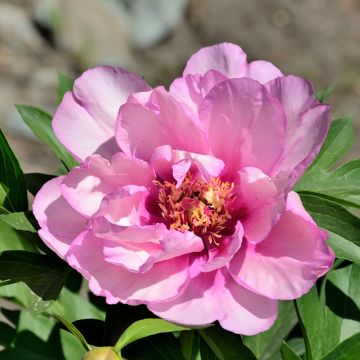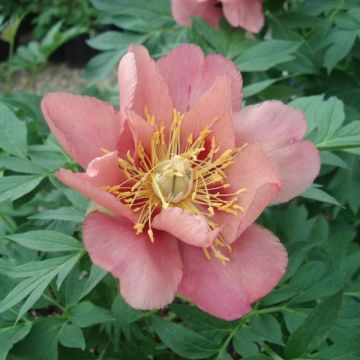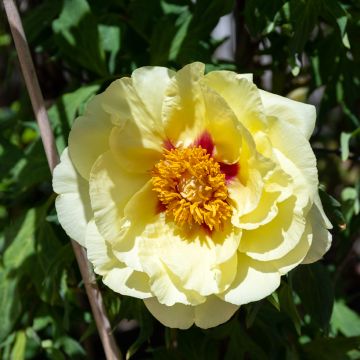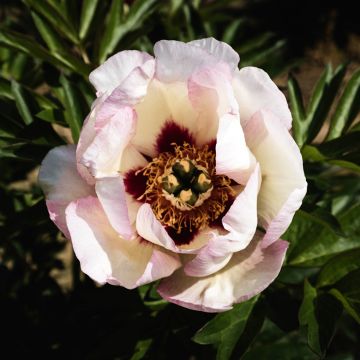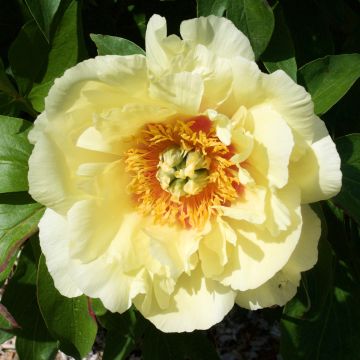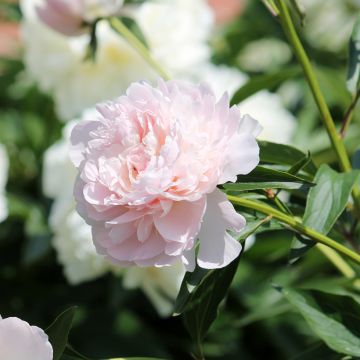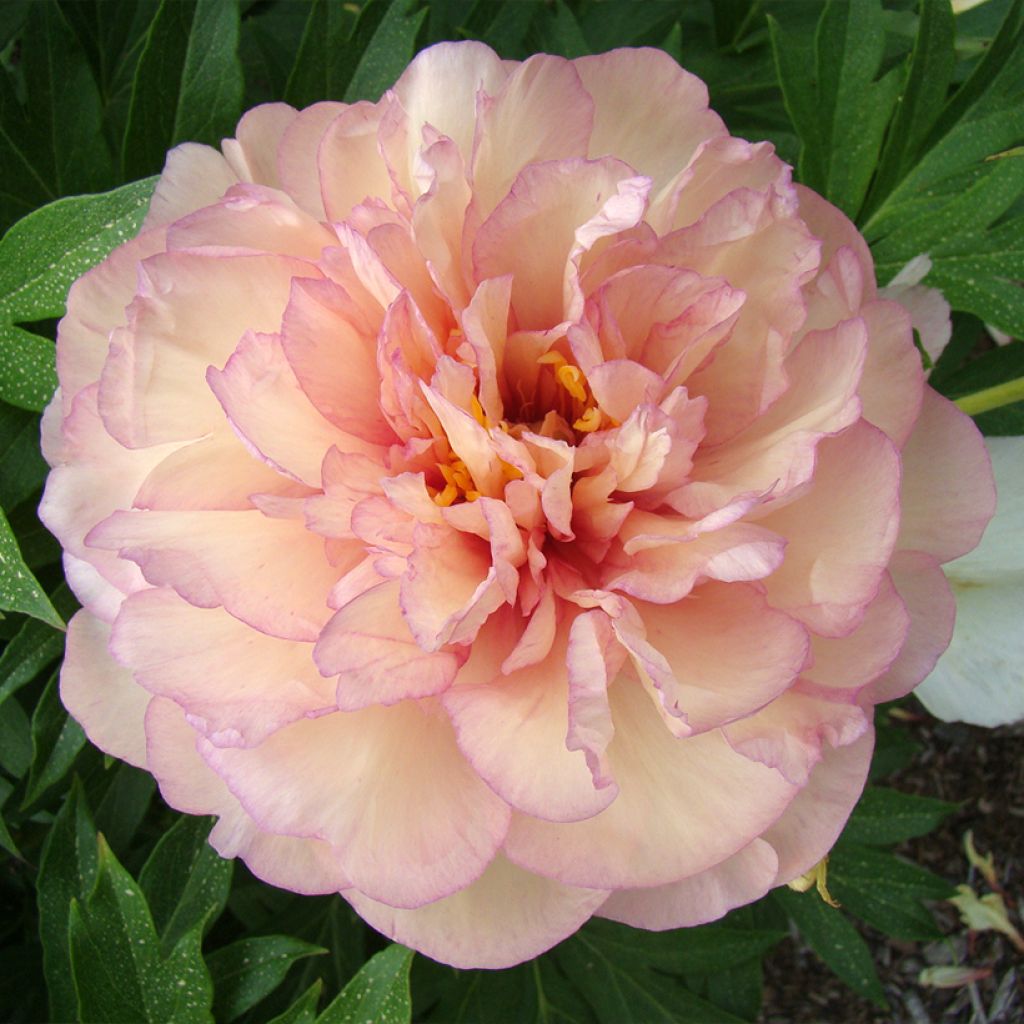

Paeonia x Itoh Scrumdidleyumptious - Intersectional Peony
Paeonia x Itoh Scrumdidleyumptious - Intersectional Peony
Paeonia x Itoh Scrumdidleyumptious
Intersectional Peony, Itoh Peony
This item cannot be shipped to the selected country
Delivery charge from €5.90
Delivery charge from €5.90
More information
Schedule delivery date,
and select date in basket
This plant carries a 12 months recovery warranty
More information
We guarantee the quality of our plants for a full growing cycle, and will replace at our expense any plant that fails to recover under normal climatic and planting conditions.
From €5.90 for pickup delivery and €6.90 for home delivery
Express home delivery from €8.90.
From €5.90 for pickup delivery and €6.90 for home delivery
Express home delivery from €8.90.
Does this plant fit my garden?
Set up your Plantfit profile →
Description
The Paeonia itoh 'Scrumdidleyumptious' is a hybrid peony that combines the best qualities of herbaceous and shrub peonies. This variety is sought after for its large, shimmering semi-double to double flowers, and its foliage that remains beautiful until autumn. Very decorative in late spring, this peony is an excellent plant for borders, hardy and robust. It blooms for a long time, starting from mid-May, on particularly lush and decorative foliage.
This 'Scrumdidleyumptious' hybrid herbaceous peony belongs, like its two parents, to the paeoniaceae family. Itoh peonies are the result of the work carried out by the Japanese breeder Toichi Itoh, starting in 1948, who gave them his name. These plants, referred to as intersectional hybrids, are exceptional perennials that combine the vigor of herbaceous peonies with all the splendour of shrub peonies, both in terms of foliage and flowering.
The Paeonia itoh 'Scrumdidleyumptious' is the result of a cross between the herbaceous peony lactiflora 'Martha W.' and the shrub peony 'Golden Era'. This cultivar was obtained in the United States in 2002 by Smith. Its growth is rather slow, but faster than that of shrub peonies. Reaching a height of 75-80 cm, this peony has an upright habit with slightly arched stems. Its semi-double to double flowers have between 30 and 50 petals and measure up to 15 cm in diameter. They are a light cream yellow, delicately edged with coral pink, and appear from May onwards. These flowers emit a sweet and pleasant fragrance. Each stem can carry 2 to 3 buds, with additional lateral buds, extending the flowering period to two and a half weeks. Flowers of different shades are sometimes observed on the same plant, which can produce up to 50 flowers during the season. The centre of each corolla is occupied by golden yellow stamens, providing a nice contrast. The dark green foliage is disease-resistant and remains attractive until autumn. The vegetation disappears in winter, with buds remaining below the soil surface.
The Paeonia itoh 'Scrumdidleyumptious' is planted in a sunny border, but not in an excessively hot location. It pairs particularly well with white roses, blue delphiniums, lavenders, and tall bearded irises. It is an exceptional plant that deserves a prime location. It is often planted in groups of 3 specimens in a shrub or perennial border. Among the small shrubs that harmonise well with this 'Scrumdidleyumptious' itoh peony, we can mention Deutzia gracilis 'Nikko', Spiraea arguta or Physocarpus opulifolius 'Magic Ball'.
Report an error about the product description
Flowering
Foliage
Plant habit
Botanical data
Paeonia
x Itoh
Scrumdidleyumptious
Paeoniaceae
Intersectional Peony, Itoh Peony
Cultivar or hybrid
Other Itoh Peonies - intersectional Peonies
Planting and care
The Itoh Peony 'Scrumdidleyumptious' should be planted from mid-September to April, with a spacing of 80 cm, in a fertile, deep, humus-bearing, moist and well-drained soil. Choose a sunny, but not scorching, location, or partial shade in hot regions. Avoid permanent mulching, as it can introduce diseases, and apply rose fertiliser or compost in March. Pruning is unnecessary, but remove faded flowers and stained parts to prevent fungal diseases. Divide old clumps in autumn, only if the plant becomes overcrowded. Be careful, as it has fragile roots and does not like to be moved. Following this operation, it may not flower for several years. Cut the foliage to ground level from February to April, or from October to November. Consider using a support stake to support the floral stems if necessary.
Planting period
Intended location
Care
This item has not been reviewed yet - be the first to leave a review about it.
Spring flowering perennials
Haven't found what you were looking for?
Hardiness is the lowest winter temperature a plant can endure without suffering serious damage or even dying. However, hardiness is affected by location (a sheltered area, such as a patio), protection (winter cover) and soil type (hardiness is improved by well-drained soil).

Photo Sharing Terms & Conditions
In order to encourage gardeners to interact and share their experiences, Promesse de fleurs offers various media enabling content to be uploaded onto its Site - in particular via the ‘Photo sharing’ module.
The User agrees to refrain from:
- Posting any content that is illegal, prejudicial, insulting, racist, inciteful to hatred, revisionist, contrary to public decency, that infringes on privacy or on the privacy rights of third parties, in particular the publicity rights of persons and goods, intellectual property rights, or the right to privacy.
- Submitting content on behalf of a third party;
- Impersonate the identity of a third party and/or publish any personal information about a third party;
In general, the User undertakes to refrain from any unethical behaviour.
All Content (in particular text, comments, files, images, photos, videos, creative works, etc.), which may be subject to property or intellectual property rights, image or other private rights, shall remain the property of the User, subject to the limited rights granted by the terms of the licence granted by Promesse de fleurs as stated below. Users are at liberty to publish or not to publish such Content on the Site, notably via the ‘Photo Sharing’ facility, and accept that this Content shall be made public and freely accessible, notably on the Internet.
Users further acknowledge, undertake to have ,and guarantee that they hold all necessary rights and permissions to publish such material on the Site, in particular with regard to the legislation in force pertaining to any privacy, property, intellectual property, image, or contractual rights, or rights of any other nature. By publishing such Content on the Site, Users acknowledge accepting full liability as publishers of the Content within the meaning of the law, and grant Promesse de fleurs, free of charge, an inclusive, worldwide licence for the said Content for the entire duration of its publication, including all reproduction, representation, up/downloading, displaying, performing, transmission, and storage rights.
Users also grant permission for their name to be linked to the Content and accept that this link may not always be made available.
By engaging in posting material, Users consent to their Content becoming automatically accessible on the Internet, in particular on other sites and/or blogs and/or web pages of the Promesse de fleurs site, including in particular social pages and the Promesse de fleurs catalogue.
Users may secure the removal of entrusted content free of charge by issuing a simple request via our contact form.
The flowering period indicated on our website applies to countries and regions located in USDA zone 8 (France, the United Kingdom, Ireland, the Netherlands, etc.)
It will vary according to where you live:
- In zones 9 to 10 (Italy, Spain, Greece, etc.), flowering will occur about 2 to 4 weeks earlier.
- In zones 6 to 7 (Germany, Poland, Slovenia, and lower mountainous regions), flowering will be delayed by 2 to 3 weeks.
- In zone 5 (Central Europe, Scandinavia), blooming will be delayed by 3 to 5 weeks.
In temperate climates, pruning of spring-flowering shrubs (forsythia, spireas, etc.) should be done just after flowering.
Pruning of summer-flowering shrubs (Indian Lilac, Perovskia, etc.) can be done in winter or spring.
In cold regions as well as with frost-sensitive plants, avoid pruning too early when severe frosts may still occur.
The planting period indicated on our website applies to countries and regions located in USDA zone 8 (France, United Kingdom, Ireland, Netherlands).
It will vary according to where you live:
- In Mediterranean zones (Marseille, Madrid, Milan, etc.), autumn and winter are the best planting periods.
- In continental zones (Strasbourg, Munich, Vienna, etc.), delay planting by 2 to 3 weeks in spring and bring it forward by 2 to 4 weeks in autumn.
- In mountainous regions (the Alps, Pyrenees, Carpathians, etc.), it is best to plant in late spring (May-June) or late summer (August-September).
The harvesting period indicated on our website applies to countries and regions in USDA zone 8 (France, England, Ireland, the Netherlands).
In colder areas (Scandinavia, Poland, Austria...) fruit and vegetable harvests are likely to be delayed by 3-4 weeks.
In warmer areas (Italy, Spain, Greece, etc.), harvesting will probably take place earlier, depending on weather conditions.
The sowing periods indicated on our website apply to countries and regions within USDA Zone 8 (France, UK, Ireland, Netherlands).
In colder areas (Scandinavia, Poland, Austria...), delay any outdoor sowing by 3-4 weeks, or sow under glass.
In warmer climes (Italy, Spain, Greece, etc.), bring outdoor sowing forward by a few weeks.

































